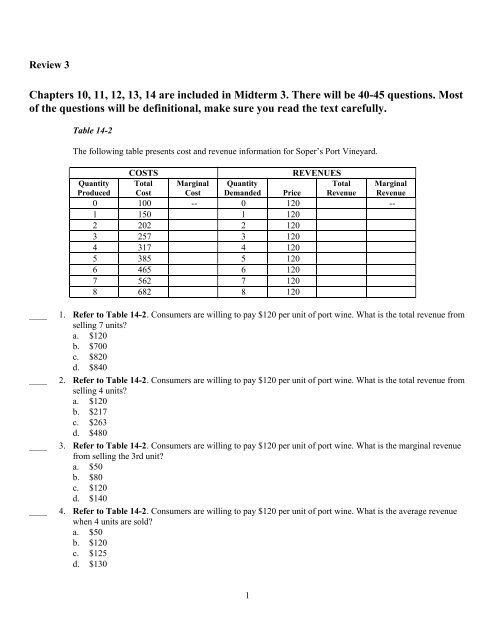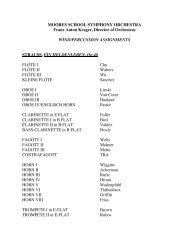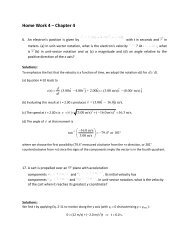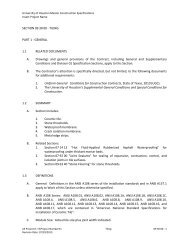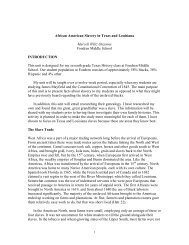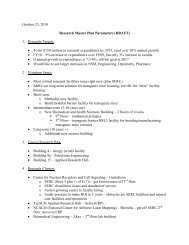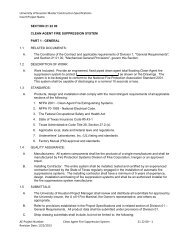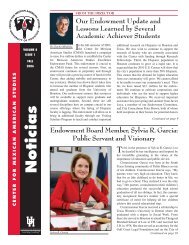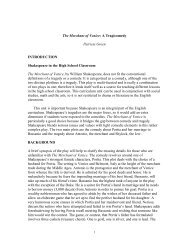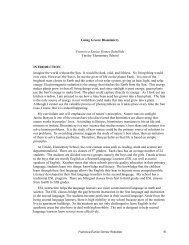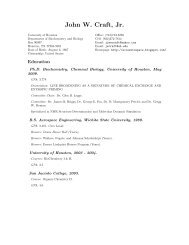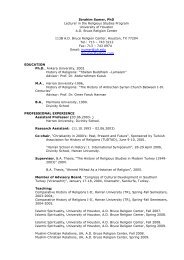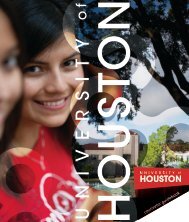Chapters 10, 11, 12, 13, 14 are included
Chapters 10, 11, 12, 13, 14 are included
Chapters 10, 11, 12, 13, 14 are included
You also want an ePaper? Increase the reach of your titles
YUMPU automatically turns print PDFs into web optimized ePapers that Google loves.
Review 3<br />
<strong>Chapters</strong> <strong>10</strong>, <strong>11</strong>, <strong>12</strong>, <strong>13</strong>, <strong>14</strong> <strong>are</strong> <strong>included</strong> in Midterm 3. There will be 40-45 questions. Most<br />
of the questions will be definitional, make sure you read the text c<strong>are</strong>fully.<br />
Table <strong>14</strong>-2<br />
The following table presents cost and revenue information for Soper’s Port Vineyard.<br />
COSTS REVENUES<br />
Quantity Total Marginal Quantity<br />
Total Marginal<br />
Produced Cost Cost Demanded Price Revenue Revenue<br />
0 <strong>10</strong>0 -- 0 <strong>12</strong>0 --<br />
1 150 1 <strong>12</strong>0<br />
2 202 2 <strong>12</strong>0<br />
3 257 3 <strong>12</strong>0<br />
4 317 4 <strong>12</strong>0<br />
5 385 5 <strong>12</strong>0<br />
6 465 6 <strong>12</strong>0<br />
7 562 7 <strong>12</strong>0<br />
8 682 8 <strong>12</strong>0<br />
____ 1. Refer to Table <strong>14</strong>-2. Consumers <strong>are</strong> willing to pay $<strong>12</strong>0 per unit of port wine. What is the total revenue from<br />
selling 7 units?<br />
a. $<strong>12</strong>0<br />
b. $700<br />
c. $820<br />
d. $840<br />
____ 2. Refer to Table <strong>14</strong>-2. Consumers <strong>are</strong> willing to pay $<strong>12</strong>0 per unit of port wine. What is the total revenue from<br />
selling 4 units?<br />
a. $<strong>12</strong>0<br />
b. $217<br />
c. $263<br />
d. $480<br />
____ 3. Refer to Table <strong>14</strong>-2. Consumers <strong>are</strong> willing to pay $<strong>12</strong>0 per unit of port wine. What is the marginal revenue<br />
from selling the 3rd unit?<br />
a. $50<br />
b. $80<br />
c. $<strong>12</strong>0<br />
d. $<strong>14</strong>0<br />
____ 4. Refer to Table <strong>14</strong>-2. Consumers <strong>are</strong> willing to pay $<strong>12</strong>0 per unit of port wine. What is the average revenue<br />
when 4 units <strong>are</strong> sold?<br />
a. $50<br />
b. $<strong>12</strong>0<br />
c. $<strong>12</strong>5<br />
d. $<strong>13</strong>0<br />
1
Name: ________________________ ID: A<br />
____ 5. Refer to Table <strong>14</strong>-2. Consumers <strong>are</strong> willing to pay $<strong>12</strong>0 per unit of port wine. What is the marginal cost of<br />
the 1st unit?<br />
a. $50<br />
b. $75<br />
c. $80<br />
d. $150<br />
____ 6. Refer to Table <strong>14</strong>-2. Consumers <strong>are</strong> willing to pay $<strong>12</strong>0 per unit of port wine. What is the marginal cost of<br />
the 8th unit?<br />
a. $0<br />
b. $<strong>10</strong>0<br />
c. $<strong>12</strong>0<br />
d. $<strong>14</strong>0<br />
____ 7. Refer to Table <strong>14</strong>-2. Consumers <strong>are</strong> willing to pay $<strong>12</strong>0 per unit of port wine. What is Soper's Port<br />
Vineyard's economic profit at their profit maximizing point?<br />
a. $78<br />
b. $243<br />
c. $278<br />
d. $375<br />
Figure <strong>10</strong>-1<br />
____ 8. Refer to Figure <strong>10</strong>-1. This graph represents the tobacco industry. The industry creates<br />
a. positive externalities.<br />
b. negative externalities.<br />
c. no externalities.<br />
d. no equilibrium in the market.<br />
2
Name: ________________________ ID: A<br />
____ 9. Refer to Figure <strong>10</strong>-1. This graph represents the tobacco industry. Without any government intervention, the<br />
equilibrium price and quantity <strong>are</strong><br />
a. $1.90 and 38 units, respectively.<br />
b. $1.80 and 35 units, respectively.<br />
c. $1.60 and 42 units, respectively.<br />
d. $1.35 and 58 units, respectively.<br />
____ <strong>10</strong>. Refer to Figure <strong>10</strong>-1. This graph represents the tobacco industry. The socially optimal price and quantity <strong>are</strong><br />
a. $1.90 and 38 units, respectively.<br />
b. $1.80 and 35 units, respectively.<br />
c. $1.60 and 42 units, respectively.<br />
d. $1.35 and 58 units, respectively.<br />
Table <strong>12</strong>-5<br />
Income Tax rate<br />
$0 to $40,000 20%<br />
Over $40,000 50%<br />
____ <strong>11</strong>. Refer to Table <strong>12</strong>-5. What is the marginal tax rate for a person who makes $35,000?<br />
a. 20%<br />
b. 30%<br />
c. 40%<br />
d. 50%<br />
____ <strong>12</strong>. Refer to Table <strong>12</strong>-5. What is the marginal tax rate for a person who makes $60,000?<br />
a. 20%<br />
b. 30%<br />
c. 40%<br />
d. 50%<br />
____ <strong>13</strong>. Refer to Table <strong>12</strong>-5. What is the average tax rate for a person who makes $60,000?<br />
a. 20%<br />
b. 30%<br />
c. 40%<br />
d. 50%<br />
____ <strong>14</strong>. XYZ corporation produced 300 units of output but sold only 275 of the units it produced. The average cost of<br />
production for each unit of output produced was $<strong>10</strong>0. Each of the 275 units sold was sold for a price of $95.<br />
Total profit for the XYZ corporation would be<br />
a. -$3,875.<br />
b. $26,<strong>12</strong>5.<br />
c. $28,500.<br />
d. $30,000.<br />
3
Name: ________________________ ID: A<br />
Scenario <strong>13</strong>-1<br />
Joe wants to start his own business. The business he wants to start will require that he purchase a factory that<br />
costs $400,000. Joe currently has $500,000 in the bank earning 3 percent interest per year.<br />
____ 15. Refer to Scenario <strong>13</strong>-1. Suppose Joe purchases the factory using $200,000 of his own money and $200,000<br />
borrowed from a bank at an interest rate of 6 percent. What is Joe’s annual opportunity cost of purchasing the<br />
factory?<br />
a. $3,000<br />
b. $6,000<br />
c. $15,000<br />
d. $18,000<br />
____ 16. Suppose a certain firm is able to produce 165 units of output per day when 15 workers <strong>are</strong> hired. The firm is<br />
able to produce 176 units of output per day when 16 workers <strong>are</strong> hired (holding other inputs fixed). Then the<br />
marginal product of the 16th worker is<br />
a. <strong>10</strong> units of output.<br />
b. <strong>11</strong> units of output.<br />
c. 16 units of output.<br />
d. 176 units of output.<br />
Table <strong>13</strong>-2<br />
Number of Workers Output<br />
0 0<br />
1 50<br />
2 1<strong>10</strong><br />
3 180<br />
4 260<br />
5 330<br />
____ 17. Refer to Table <strong>13</strong>-2. What is the marginal product of the fourth worker?<br />
a. 65<br />
b. 70<br />
c. 75<br />
d. 80<br />
____ 18. Refer to Table <strong>13</strong>-2. At which number of workers does diminishing marginal product begin?<br />
a. 2<br />
b. 3<br />
c. 4<br />
d. 5<br />
4
Name: ________________________ ID: A<br />
Table <strong>13</strong>-3<br />
Number<br />
of<br />
Workers<br />
Number<br />
of<br />
Machines<br />
Output<br />
(corks<br />
produced<br />
per hour)<br />
1 2 5<br />
2 2 <strong>10</strong><br />
3 2 20<br />
4 2 35<br />
5 2 55<br />
6 2 70<br />
7 2 80<br />
Marginal<br />
Product of<br />
Labor<br />
5<br />
Cost of<br />
Workers<br />
Cost of<br />
Machines<br />
____ 19. Refer to Table <strong>13</strong>-3. Each worker at Gallo's cork factory costs $<strong>12</strong> per hour. The cost of each machine is $20<br />
per day regardless of the number of corks produced. If Gallo's produces at a rate of 70 corks per hour and<br />
operates 8 hours per day, what is Gallo’s total labor cost per day?<br />
a. $72<br />
b. $96<br />
c. $480<br />
d. $576<br />
Table <strong>13</strong>-6<br />
Adrian's Premium Chocolates produces boxes of chocolates for its mail order catalogue business. She rents a<br />
small room for $150 a week in the downtown business district that serves as her factory. She can hire<br />
workers for $275 a week. There <strong>are</strong> no implicit costs.<br />
Boxes of<br />
Chocolates<br />
Produced per<br />
Marginal<br />
Product<br />
of Labor<br />
Cost<br />
of<br />
Workers<br />
Total<br />
Cost<br />
Total Cost<br />
of<br />
Inputs<br />
Number of<br />
Cost of<br />
Workers Week<br />
Factory<br />
0 0<br />
1 330 150 275 425<br />
2 630<br />
3 150 825 975<br />
4 890<br />
5 950 60 1,375<br />
6 <strong>10</strong> 1,800<br />
____ 20. Refer to Table <strong>13</strong>-6. What is the marginal product of the second worker?<br />
a. 1<strong>10</strong><br />
b. 200<br />
c. 260<br />
d. 300
Name: ________________________ ID: A<br />
____ 21. Refer to Table <strong>13</strong>-6. What is the total cost associated with making 890 boxes of premium chocolates per<br />
week?<br />
a. $1,250<br />
b. $1,325<br />
c. $1,400<br />
d. $1,575<br />
____ 22. Refer to Table <strong>13</strong>-6. During the week of July 4th, Adrian doesn't box any chocolates. What <strong>are</strong> her costs<br />
during the week?<br />
a. $0<br />
b. $150<br />
c. $275<br />
d. $425<br />
____ 23. Refer to Table <strong>13</strong>-6. One week, Adrian earns a profit of $<strong>12</strong>5. If her revenue for the week is $1<strong>10</strong>0, how<br />
many boxes of chocolate did she produce?<br />
a. <strong>14</strong>0<br />
b. 330<br />
c. 780<br />
d. 950<br />
Table <strong>13</strong>-9<br />
Output Total Cost<br />
0 40<br />
<strong>10</strong> 60<br />
20 90<br />
30 <strong>13</strong>0<br />
40 180<br />
50 240<br />
____ 24. Refer to Table <strong>13</strong>-9. What is the total fixed cost for this firm?<br />
a. $20<br />
b. $30<br />
c. $40<br />
d. $50<br />
____ 25. Refer to Table <strong>13</strong>-9. What is average fixed cost when output is 40 units?<br />
a. $1.00<br />
b. $3.32<br />
c. $5.00<br />
d. $8.00<br />
____ 26. Refer to Table <strong>13</strong>-9. What is average variable cost when output is 50 units?<br />
a. $3.60<br />
b. $4.00<br />
c. $4.40<br />
d. $4.80<br />
6
Name: ________________________ ID: A<br />
____ 27. Refer to Table <strong>13</strong>-9. What is variable cost when output equals 30 units?<br />
a. $4.00<br />
b. $4.33<br />
c. $40.00<br />
d. $90.00<br />
Table <strong>13</strong>-<strong>10</strong><br />
Consider the following table of long-run total cost for four different firms<br />
Quantity 1 2 3 4 5 6 7<br />
Firm 1 $2<strong>10</strong> $340 $490 $660 $850 $1,060 $1,290<br />
Firm 2 $180 $350 $5<strong>10</strong> $660 $800 $930 $1,050<br />
Firm 3 $<strong>12</strong>0 $250 $390 $540 $700 $870 $1,050<br />
Firm 4 $150 $300 $450 $600 $750 $900 $1,050<br />
____ 28. Refer to Table <strong>13</strong>-<strong>10</strong>. Which firm has constant returns to scale over the entire range of output?<br />
a. Firm 1<br />
b. Firm 2<br />
c. Firm 3<br />
d. Firm 4<br />
7
Review 3<br />
Answer Section<br />
MULTIPLE CHOICE<br />
1. ANS: D DIF: 2 REF: <strong>14</strong>-1 TOP: Total revenue<br />
MSC: Applicative<br />
2. ANS: D DIF: 2 REF: <strong>14</strong>-1 TOP: Total revenue<br />
MSC: Applicative<br />
3. ANS: C DIF: 2 REF: <strong>14</strong>-1 TOP: Marginal revenue<br />
MSC: Applicative<br />
4. ANS: B DIF: 2 REF: <strong>14</strong>-1 TOP: Average revenue<br />
MSC: Applicative<br />
5. ANS: A DIF: 2 REF: <strong>14</strong>-2 TOP: Marginal cost<br />
MSC: Applicative<br />
6. ANS: C DIF: 2 REF: <strong>14</strong>-2 TOP: Marginal cost<br />
MSC: Applicative<br />
7. ANS: C DIF: 2 REF: <strong>14</strong>-2 TOP: Economic profit<br />
MSC: Applicative<br />
8. ANS: B DIF: 2 REF: <strong>10</strong>-1 TOP: Externalities<br />
MSC: Applicative<br />
9. ANS: C DIF: 2 REF: <strong>10</strong>-1 TOP: Externalities<br />
MSC: Applicative<br />
<strong>10</strong>. ANS: B DIF: 2 REF: <strong>10</strong>-1 TOP: Externalities<br />
MSC: Applicative<br />
<strong>11</strong>. ANS: A DIF: 2 REF: <strong>12</strong>-2 TOP: Marginal tax rates<br />
MSC: Analytical<br />
<strong>12</strong>. ANS: D DIF: 2 REF: <strong>12</strong>-2 TOP: Marginal tax rates<br />
MSC: Analytical<br />
<strong>13</strong>. ANS: B DIF: 3 REF: <strong>12</strong>-2 TOP: Average tax rates<br />
MSC: Analytical<br />
<strong>14</strong>. ANS: A DIF: 2 REF: <strong>13</strong>-1 TOP: Profit<br />
MSC: Applicative<br />
15. ANS: D DIF: 2 REF: <strong>13</strong>-1 TOP: Opportunity cost<br />
MSC: Applicative<br />
16. ANS: B DIF: 1 REF: <strong>13</strong>-2 TOP: Marginal product of labor<br />
MSC: Applicative<br />
17. ANS: D DIF: 2 REF: <strong>13</strong>-2 TOP: Marginal product<br />
MSC: Analytical<br />
18. ANS: D DIF: 1 REF: <strong>13</strong>-2 TOP: Marginal product<br />
MSC: Analytical<br />
19. ANS: D DIF: 2 REF: <strong>13</strong>-2 TOP: Variable costs<br />
MSC: Applicative<br />
20. ANS: D DIF: 2 REF: <strong>13</strong>-3 TOP: Marginal product of labor<br />
MSC: Applicative<br />
1<br />
ID: A
21. ANS: A DIF: 2 REF: <strong>13</strong>-3 TOP: Total cost<br />
MSC: Applicative<br />
22. ANS: B DIF: 2 REF: <strong>13</strong>-3 TOP: Fixed costs<br />
MSC: Applicative<br />
23. ANS: C DIF: 2 REF: <strong>13</strong>-3 TOP: Accounting profit<br />
MSC: Applicative<br />
24. ANS: C DIF: 2 REF: <strong>13</strong>-4 TOP: Fixed costs<br />
MSC: Analytical<br />
25. ANS: A DIF: 3 REF: <strong>13</strong>-4 TOP: Average fixed cost<br />
MSC: Analytical<br />
26. ANS: B DIF: 3 REF: <strong>13</strong>-4 TOP: Average variable cost<br />
MSC: Analytical<br />
27. ANS: D DIF: 2 REF: <strong>13</strong>-4 TOP: Variable costs<br />
MSC: Analytical<br />
28. ANS: D DIF: 2 REF: <strong>13</strong>-4 TOP: Constant returns to scale<br />
MSC: Applicative<br />
2<br />
ID: A


